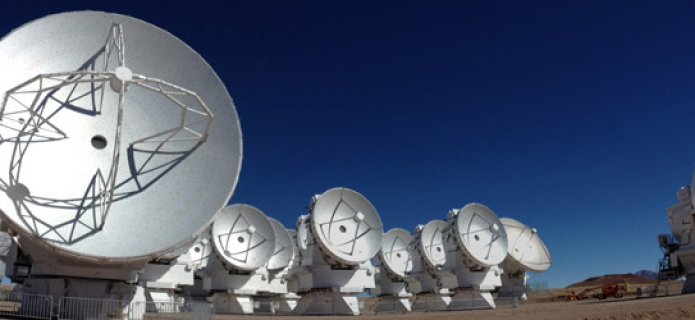Final ACA Antenna Delivered: The “Morita Array”
The 12th 7-m antenna developed by Japan was delivered to the high site in Chajnantor on April 29, 2013. Now all the 16 antennas of the Atacama Compact Array (ACA) are installed at the Array Operations Site at an altitude of 5,000 m, waiting to unveil secrets of the universe.
ALMA, the Atacama Large Millimeter/submillimeter Array, is an international partnership of East Asia, Europe and North America in cooperation with the Republic of Chile, to build a giant radio telescope by connecting 66 high-precision antennas. In this global venture, Japan is responsible for the development of 16 antennas (four 12-m antennas and twelve 7-m antennas), ultra-cooled radio receivers for three frequency bands which are installed in all 66 antennas, and a high-speed computer, called the Correlator, to combine the signals collected by 16 Japanese antennas. The Atacama Compact Array, a major deliverable from Japan to the ALMA project, consists of the 16 antennas and receivers installed therein and the ACA Correlator. The ACA is able to enhance the images of celestial objects that have large angular size, such as molecular clouds and nearby galaxies, thus improving ALMA’s image fidelity.
The last 7-m antenna was loaded on a custom-built transporter and taken from ALMA’s Operation Support Facility (OSF, at an altitude of 2,900 m above sea level) at 10:30 a.m. on April 29th. After six hours of careful transportation, the antenna was placed in the correct position at the AOS. This was three-and-a-half years after the transporting of the first antenna to the high site in 2009.
Satoru Iguchi, East Asia ALMA Project Manager and professor at the National Astronomical Observatory of Japan (NAOJ), recalled the history of ALMA's construction, saying "This wonderful milestone of the completion of the ACA antennas was finally achieved thanks to the countless efforts of the NAOJ ALMA antenna team led by Norikazu Mizuno, the East Asia ALMA System Engineering and System Integration Manager, as well as all the related staff in the Joint ALMA Observatory (JAO). Now, the ACA starts to show its full capability. By adding the ACA, ALMA can produce high-fidelity radio images to understand the birth and evolution of planetary systems and galaxies, and hopefully the origin of life."
The ALMA Board unanimously decided that the Atacama Compact Array (ACA) will be named the "Morita Array" after Professor Koh-ichiro Morita, one of the world's renowned scientists in the field of "aperture synthesis." Morita-san passed away suddenly on May 7, 2012 in Santiago. This is the first time that a telescope has been named after a Japanese astronomer.
Koh-ichiro Morita, a professor at the NAOJ Chile Observatory, was involved in the construction of the Nobeyama Millimeter Array in the 1980s, and in the 2000s he joined the ALMA project. He made a great contribution to designing the configuration of the 16 antennas composing the ACA, as well as to high-resolution and high-quality imaging at millimeter/submillimeter wavelengths to further enhance ALMA's performance. In 2010, he became a member of the JAO in Chile and served as leader of an international team of scientists carrying out ALMA system verification and evaluation.
"Professor Morita played a central role in building the concept of ACA and made it a reality as the largest contribution from Japan to ALMA. All our partners are delighted to put his name on the array," explained Masahiko Hayashi, the Director General of the NAOJ. "Although it is hard to overcome the sadness of his loss, this new honor for Professor Morita helps us."
As described above, the Morita Array is designed for precise imaging of extended celestial objects. Professor Morita himself created the best configuration for the array, which involved determining the proper number and diameters of antennas through many computer simulation studies. The system verification observations clearly showed that Professor Morita’s design of the array accomplished the objective, and the Morita Array is used for scientific observations now. The unique functions of the telescope bearing Professor Morita’s name will add new pages to astronomy books, as was his intention.
Contact:
Valeria Foncea
Education and Public Outreach Officer,
Joint ALMA Observatory
Santiago, Chile
Tel: +56 2 2467 6258
Cell: +56 9 7587 1963
Email: [email protected]
Masaaki Hiramatsu
Education and Public Outreach Officer, NAOJ Chile
Observatory Tokyo, Japan
Tel: +81 422 34 3630
E-mail: [email protected]
Richard Hook
Public Information Officer, ESO
Garching bei München, Germany
Tel: +49 89 3200 6655
Cell: +49 151 1537 3591
Email: [email protected]
Charles E. Blue
Public Information Officer
National Radio Astronomy Observatory
Charlottesville, Virginia, USA
Tel: +1 434 296 0314
Cell: +1 434.242.9559
E-mail: [email protected]
